
A frontbend is a contortion position where the body is curved forward at the hips and spine. In an extreme frontbend, some contortionists can place the backs of their knees behind their shoulders.

A frontbend is a contortion position where the body is curved forward at the hips and spine. In an extreme frontbend, some contortionists can place the backs of their knees behind their shoulders.
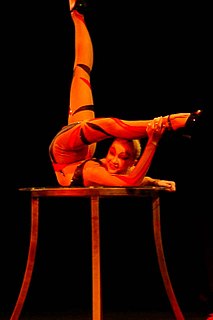
Contortion is a performance art in which performers called contortionists showcase their skills of extreme physical flexibility. Contortion acts often accompany acrobatics, circus acts, street performers and other live performing arts. Contortion acts are typically performed in front of a live audience. An act will showcase one or more artists performing a choreographed set of moves or poses, often to music, which require extreme flexibility. The physical flexibility required to perform such acts greatly exceeds that of the general population. It is the dramatic feats of seemingly inhuman flexibility that captivate audiences.
Because ballet became formalized in France, a significant part of ballet terminology is in the French language.
Professional wrestling holds include a number of set moves and pins used by performers to immobilize their opponents or lead to a submission. This article covers the various pins, stretches and transition holds used in the ring. Some wrestlers use these holds as their finishing maneuvers, often nicknaming them to reflect their character or persona. Moves are listed under general categories whenever possible.

The canter and gallop are variations on the fastest gait that can be performed by a horse or other equine. The canter is a controlled three-beat gait, while the gallop is a faster, four-beat variation of the same gait. It is a natural gait possessed by all horses, faster than most horses' trot, or ambling gaits. The gallop is the fastest gait of the horse, averaging about 40 to 48 kilometres per hour. The speed of the canter varies between 16 to 27 kilometres per hour depending on the length of the horse's stride. A variation of the canter, seen in western riding, is called a lope, and is generally quite slow, no more than 13–19 kilometres per hour (8–12 mph).

Pashchimottanasana, Seated Forward Bend, or Intense Dorsal Stretch is a seated forward-bending asana in hatha yoga and modern yoga as exercise.

The half-pass is a lateral movement seen in dressage, in which the horse moves forward and sideways at the same time. Unlike the easier leg-yield, the horse is bent in the direction of travel, slightly around the rider's inside leg. The outside hind and forelegs should cross over the inside legs, with the horse's body parallel to the arena wall and his forehand leading. The horse should remain forward, balanced, and bent, moving with cadence. The inside hind leg remains engaged throughout the half-pass, and the horse should not lose its rhythm.
An Ina Bauer is a "moves in the field" element in figure skating in which a skater skates on two parallel blades. One foot is on a forward edge and the other leg is on a backwards and different parallel edge. The forward leg is bent slightly and the trailing leg is straight. If the leading leg is on the inside edge, the move is known as an inside ina bauer. If the skater is on the outside edge, it is known as an outside ina bauer. Many skaters bend backwards while performing this move, although this is not required. The most flexible skaters can bend over almost completely backward. When performed this way, the move is called a layback Ina Bauer, after the layback position.
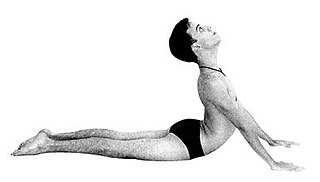
Bhujangasana or Cobra Pose is a reclining back-bending asana in hatha yoga and modern yoga as exercise. It is commonly performed in a cycle of asanas in Surya Namaskar as an alternative to Urdhva Mukha Svanasana.

Riding aids are the cues a rider gives to a horse to communicate what they want the animal to do. Riding aids are broken into the natural aids and the artificial aids.
In rowing, the stroke the main train is for the thing in order for people the boat forward. The two fundamental reference points in the stroke are the catch where the oar blade is placed in the water, and the extraction where the oar blade is removed from the water. After the blade is placed in the water at the catch, the rower applies pressure to the oar levering the boat forward which is called the drive phase of the stroke. Once the rower extracts the oar from the water, the recovery phase begins, setting up the rower's body for the next stroke.
Lateral movements or lateral flexions within equestrianism, have a specific meaning, used to refer to movements made by a horse where the animal is moving in a direction other than straight forward. They are used both in training and in competition, vary in difficulty, and are used in a progressive manner, according to the training and physical limitations of the animal.
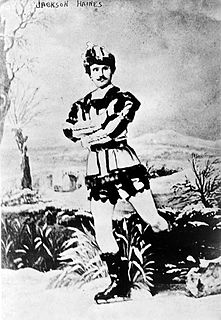
The sit spin was invented by American figure skater Jackson Haines. It has been called "one of the most important spins in skating". The spin is executed on one foot, in a sitting position, with the knee of the skating leg bent in a one-legged crouch position and the free leg held in front, to the side or to the back. It is difficult to learn, requires a great deal of energy, and is not as exciting to perform as other elements, such as jumps, but it has variations that make it more creative and pleasurable to watch. When executing the sit spin, a skater's back should be straight and not curved, their hips should be lower than the skating knee, and their free leg should be straight. The best sit spin position minimizes the moment of inertia and keeps the heaviest parts of the body as close to the vertical center of gravity as possible. This position is difficult to maintain, however, so skaters will often collapse into a low sit spin position. The ISU states that if the shin and thigh skater's leg is over approximately 120 degrees, the position is considered an upright or camel spin.
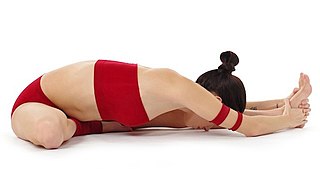
Janu Sirsasana, Head-to-Knee Pose, is a seated twisting and forward bending asana in diverse schools of modern yoga as exercise.
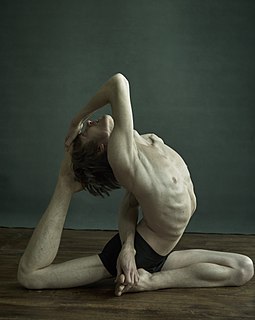
Eka Pada Rajakapotasana or [One-legged] King Pigeon Pose is a seated back-bending asana in modern yoga as exercise. The Yin Yoga form of the asana is named Swan Pose, while the Aerial yoga variant, supported in a hammock, is Flying Pigeon Pose.

Parshvottanasana or Intense Side Stretch Pose is a standing and forward bending asana in modern yoga as exercise.
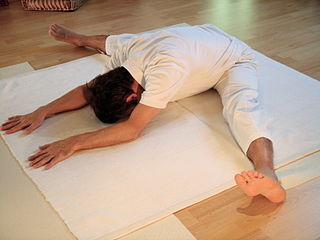
Upaviṣṭa Koṇāsana, also written Upavistha Konasana or "wide-angle seated forward bend", is an asana in modern yoga as exercise, sitting upright with the legs as wide apart as possible, grasping the toes and leaning forward.

Krauñcāsana or Heron pose, also written Krounchasana, is a sitting asana in modern yoga as exercise.
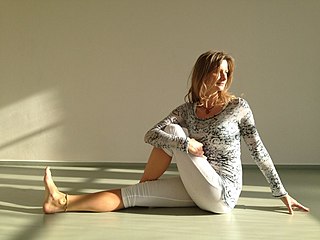
Marichyasana is a sitting twist asana in modern yoga as exercise, in some forms combined with a forward bend.

Setu Bandha Sarvāṅgāsana, Shoulder supported bridge or simply Bridge, also called Setu Bandhāsana, is an inverted back-bending asana in hatha yoga and modern yoga as exercise.